The latest Rhystic Studies podcast, published on the heels of Sam’s trip to the Lucca Comics and Games festival, was a call to action for those of us working in this space. Not just to keep doing what we do, telling the stories of Magic: The Gathering, but to elevate, to inspire, and not be afraid to get a little weird. Like any writer or creator bound by deadlines and chasing the relevancy of the release schedule, it’s hard to not fall into the rut of the same content, and the same topics over and over again. I’m as guilty of it as anyone, and this article very well could have been about any number of recently released products. But it’s not going to be. It’s about The Raft of the Medusa by Théodore Géricault.
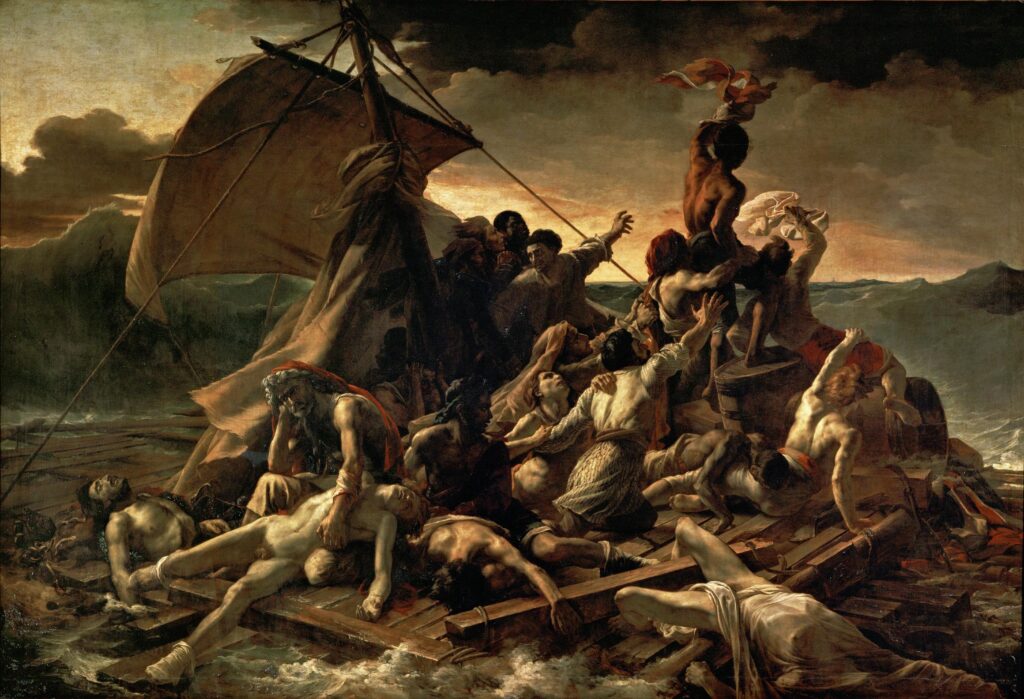
Théodore Géricault, Raft of the Medusa, 1818–19, oil on canvas, 4.91 x 7.16m (Musée du Louvre, Paris)
Now you may be thinking: Sir, this is a Magic: The Gathering art column. What does this have to do with anything?
I write about what I see, and I’m always looking. And this more than two hundred year old painting has fortuitously revealed itself to me on two different unrelated occasions over as many weeks. It’s exactly the weirdness this column needed.
My first re-encounter with this painting was in writing my Grand Art Tour for the Lost Caverns of Ixalan, with the inclusion of Frilled Cave-Wurm by Aaron Miller. When the painting was sold, the artist mentioned he was inspired by the work when creating this foreground detail.
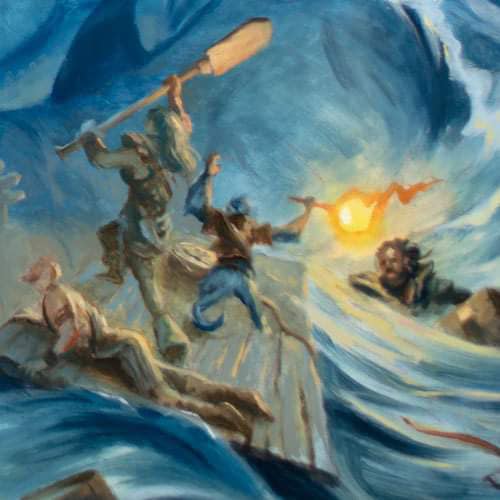
Detail, Frilled Cave-Wurm by Aaron Miller
I searched for the painting and took a look for the first time since my undergraduate art history survey course nearly 15 years ago. But it didn’t end there.
Less than a week later, I decided to finally start Art is Life by Jerry Saltz while my son was sleeping in my arms. For regular readers, you well know I am a big fan of Saltz’s writing and opinions; he’s the inspiration for the aforementioned Grand Art Tour, and I’ve listened to almost every available podcast interview he’s done in the last three years. You can imagine my surprise when I cracked that spine, and on the first page opposite the Introduction, staring back at me was a masterpiece that I had seen just one week earlier.
Images: Penguin Random House
The Work
Raft of the Medusa is an oil painting by Théodore Géricault, begun in 1818 and completed the following year. It currently resides in the Louvre, acquired shortly after the artist’s death (and notably not during its initial Paris Salon exhibition). It has lived on as one of the shining achievements of French Romanticism.
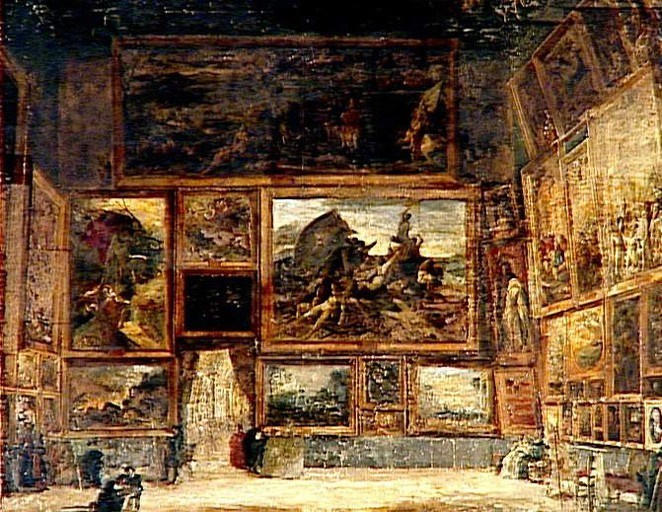
Nicolas Sebastien Maillot’s Raft of the Medusa shown in Salon Carré of the Louvre, 1831, Louvre, shows Géricault’s Raft hanging alongside works by Poussin, Lorrain, Rembrandt and Caravaggio. Photo: Nicolas Sébastien Maillot, Public domain, via Wikimedia Commons
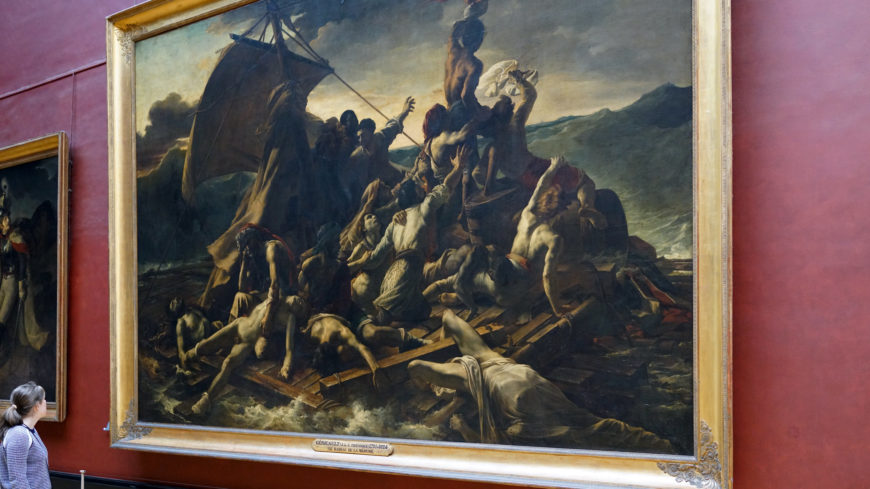
Image: SmartHistoryy- Théodore Géricault, Raft of the Medusa, 1818–19, oil on canvas, 4.91 x 7.16 m (Musée du Louvre, Paris, photo: Steven Zucker CC BY-NC-SA 2.0)
It’s a massive painting, literally larger than life at 491 cm by 716 cm (16 ft 1 in by 23 ft 6 in), and much bigger than the standard works of its time. It tells the story of the shipwreck of the French frigate Medusa, the aftermath of its survivors set adrift on a makeshift wooden raft, and the international scandal that followed. While it technically falls into the genre of ‘history painting,’ it is unusual in that it was painted almost contemporaneously, begun less than two years after the event it was depicting. The work was as much a social commentary on the current state of French society as a historical retelling. King Louis XVIII commented: “Monsieur Géricault, you’ve painted a shipwreck, but it’s not one for you,” while at the same time French historian, writer, and critic Jules Michelet said of the painting: “our whole society is aboard the raft of the Medusa.” A juxtaposition of opinion that marks the dichotomy of the work, and the perfect point of departure for the waves the painting creates to this day.
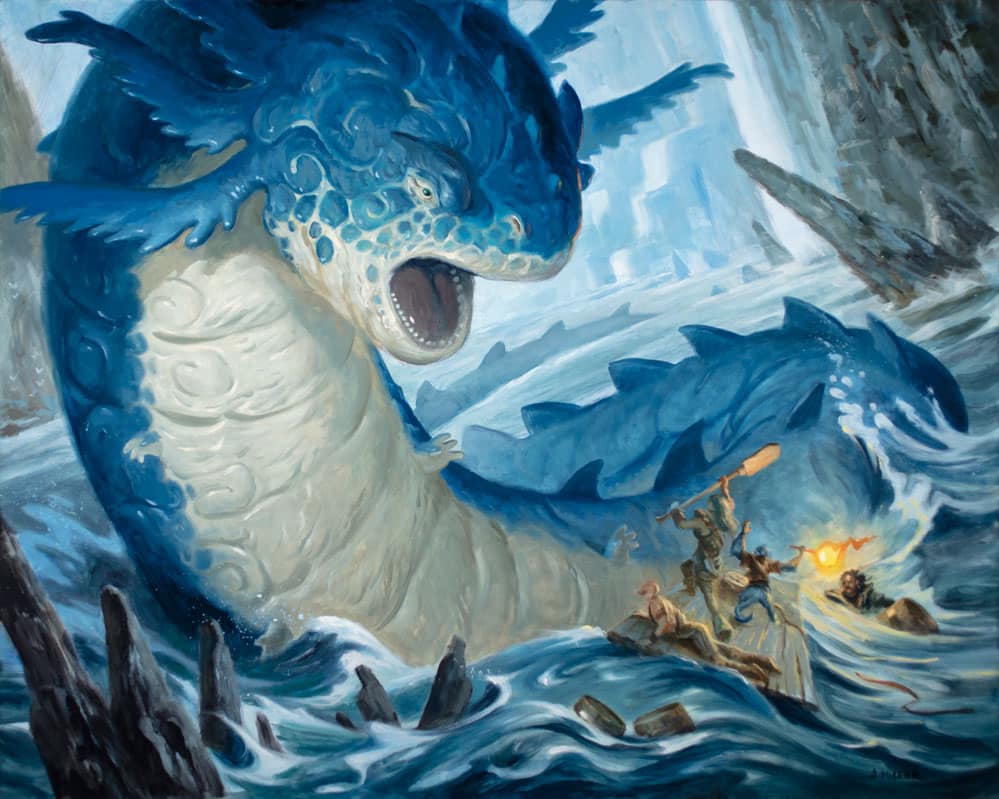
Frilled Cave-Wurm by Aaron Miller, oil on board, 16” x 20”
Frilled Cave-Wurm: A Painting Elevated
The Raft’s appearance in Frilled Cave-Wurm is ultimately ancillary; the detail we see is inspired by, as opposed to a copy or reproduction, but that does not mean it’s insignificant. Looking at the work without the raft, we would technically still have a complete painting. The creature card’s primary purpose is to represent a wurm, and it does that well. It’s set within a known place, the core of the plane of Ixalan, and the background situates us there nicely. But this small detail is no afterthought. It adds a story to the image, and elevates the work as a whole. It gives purpose to the wurm, reinforces the location, and adds another layer of emotion to the image. As a viewer, we now have questions to ask. Who are they? Did they make it? These are the same questions that folks around the world would have asked of The Raft of the Medusa upon seeing it for the first time.
It’s these storytelling elements that make a work rise from simply ‘good’ to outstanding, and make them memorable within the framework of a Magic set. Miller’s work is known for narrative atmospherics. Every time I’ve written about his paintings, it’s because he adds that extra something that transcends commercial card illustration and makes it into something full of life and full of story. His inspiration from the Raft, whether he realized it or not, made this painting one of the best he’s done for the game.
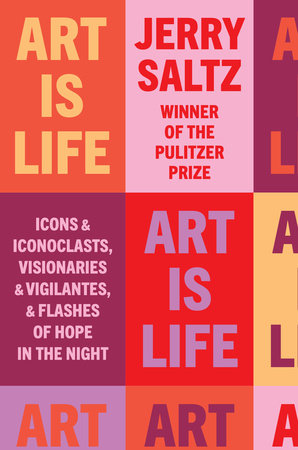
Art is Life: A Book Inspired
Art is Life by New York Magazine Senior Art Critic Jerry Saltz is the Pulitzer Prize winning author’s second book, published in November of 2022. I preordered it when first announced, having absolutely loved How To Be An Artist. But, due to a confluence of things it remained unopened on my nightstand for longer than I care to admit. It’s a collection of Saltz’s work from the last two decades together in a single volume, to function as “a real-time survey of contemporary art as a barometer of our times.” I wasn’t entirely sure what to expect, but in opening those first pages and discovering an introduction entitled “The Medusa and the Pequod,” with the image of the painting opposite the first page of text, I was instantly inquisitive, and interested to know more. I had just seen the painting, and here it was again!
What follows is Saltz’s chronicle of his first encounter with the work in the early 1970s, described as a decided turning point in his interaction with art:
“The moment I saw it, something like Krakatoa went off within me”
He goes on to tell the story of what we see from both a historical and critical perspective: setting sail, shipwreck, souls cast adrift, subsequent violence, and the snapshot in night we see here, as the white sails of the Argus break the horizon. Though fifteen would eventually be saved, this is the moment of rescue forsaken, and all hope lost. The Medusa shipwreck became Europe’s gossip in the time following the calamity, and spurned this work from Géricault, begun without a paid commission, that would live on in history.
Saltz goes on to write about art as only he can, boiling forty years of feeling since he first saw the painting into a narrative that rivals any art history article I’ve read. It’s a tale told with unparalleled passion, and I think it’s safe to say Saltz’s recount and romance of The Raft of the Medusa is a formative piece of his criticism, born from a core memory made when he first laid eyes upon it. This painting inspired Saltz’s art-centric mind more than twenty years before his first piece of writing, and is likely responsible for at least a piece of the prowess we experience today. He wrote:
“The elemental power and poetry of Géricault’s Medusa changed me forever. It told me things I’ve known and lived by ever since. To encounter a work of art for the first time is to confront, for an instant, something you’ve never seen in your life. You are reminded that what you’re looking at was once (or perhaps still is) contemporary art in direct conversation with its own time. All art is a kind of exorcism. This is what gives art its power to change the conditions of our life.”
Without this seemingly chance encounter all those years ago, and that small spark turned into a volcanic eruption, we may never have known one of the great critics of our time.
Wrapping Up
The final piece of this puzzle that Sam mentioned in his podcast was about lifting other folks up, those writers, creators and channels just beginning to push their own flywheels and explore the wide and wondrous connections Magic: The Gathering has with the rest of the world. As I was researching for this article, I came across a quote that couldn’t have been more poignant, from American novelist and poet John Updike:
“The literary scene is a kind of Medusa’s raft, small and sinking, and one’s instinct when a newcomer tries to clamber aboard is to step on his fingers.”
If you’ve made it this far, chances are you’re interested in Magic’s rich history, its art, the web it weaves into popular culture, and the things that can be learned from it. So I’ll end with a charge, to those writing, and making the Magic of today:
Find someone clambering for the raft, and extend a hand. Pull them up, just as someone once pulled you up. And then look to the horizon: it’s a wide world of amazing things out there, and the more people creating new and exciting work, the richer the community will be for it.
Donny Caltrider (he/him) is a Senior Writer at Hipsters of Coast writing about all things related to the art of Magic: The Gathering and the larger imaginative realism genre. He has an M.A. in Museum Studies from Johns Hopkins University and enjoys telling stories about art, objects, and the intersection of fantasy with real-life. When he’s not writing for Hipsters or working with artists, you can find him traveling with his wife, petting his two cats, and watching the Baltimore Orioles.

